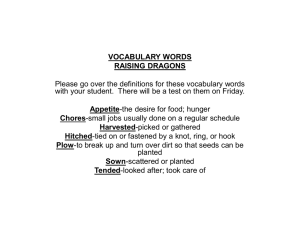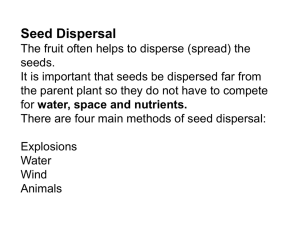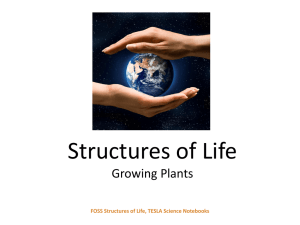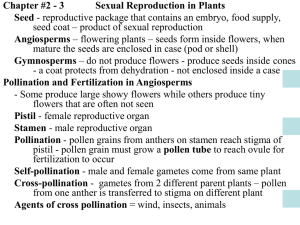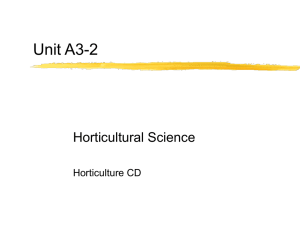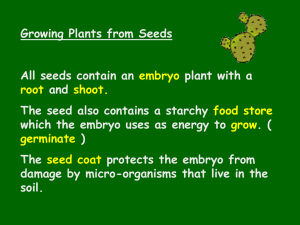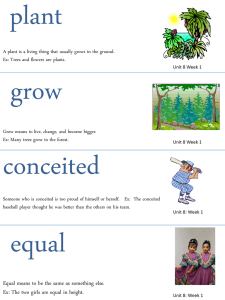Plant Propagation
advertisement
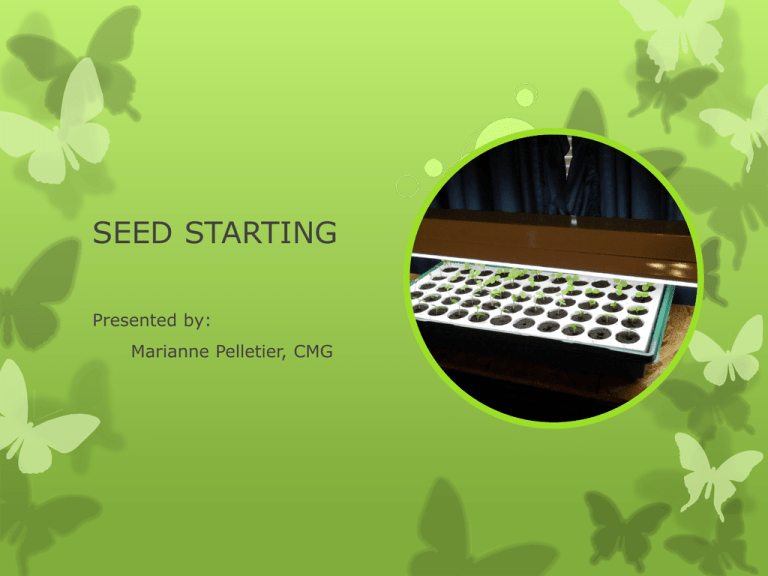
SEED STARTING Presented by: Marianne Pelletier, CMG Double Coconut Rain Forest Orchids Why Should I Start Seeds Myself You can save money For a $2 packet of seeds there is a possible of getting 10-1000 plants Swapping with fellow gardeners Saving your own seeds You have control. You know that you won’t be bringing something unwanted home You get more variety The enjoyment of seeing your seedlings emerge from the soil Before You Start Determine how much to grow What you want to grow Varieties should be selected by: Size Color Growth Habit What zone you are in Determine if you want: Heirlooms These are old, open-pollinated cultivars Hybrids This is a cross between two different plant varieties to get the attributes of each variety If you see F1 it means it is a hybrid Acquiring & Storing Seeds Acquiring Buy from a reputable seed company/catalog Storing Keep any left over seed in the packet it come in Store in a tightly closed jar or container Store at a low humidity at around 40 degrees such as the refrigerator Use silica gel, powdered milk or cornstarch to keep the relative humidity below 40%. Wilson County Planting Guide Seed Starting Supplies Label/Marker Spray Bottle Soil-Less Mix Flat/Cell trays/pots Seeds Warm Spot in Your House Optional Equipment Artificial Lights Heating Mats Cold Frame/Greenhouse Grow Lights Flower Seeds The Divas of the Seed World How to Help the Seed to Germinate Scarification Stratification Soaking Light Dark Scarification Tools Needed Small Sharp Paring Knife Sandpaper What is it? To remember what scarification means just think of the word “scar”, which is what you are doing to the seed Happens naturally when a bird swallows the seed and then passes it through the digestive system Not all seeds need scarification. The following website is a good reference www.chestnut-sw.com How To Nick the seed with the paring knife or scratch the surface of the seed with the sandpaper All seeds don’t need this method and you may kill them. Refer to www.chestnut-sw.com for a list of flowers and vegetables and how to treat them Flowers That Need Scarification Hollyhock Angels Trumpet Moon Flower False Indigos Canna Morning Glories What is Stratification? Stratification is when a gardener purposely chills the seeds. Certain seeds have a way of protecting themselves from germinating too early or too late. How The only things you will need for this method is a Ziploc bag a marker, and your seeds. Make sure to label the bag with what type of seed and the date that it is to be removed from the refrigerator Seal the bag and place it in the refrigerator. Make sure it the bag is sealed or the seeds will dry out and will not germinate Flowers That Need Stratification Snapdragon 4-6 wk Columbine 2-8 wk Coneflowers 3-6 wk Blackberry Lily 4-6 wk Lavender 4 wks Clematis 3 months Peonies 2 months Larkspur 6 wk Jacobs Ladder 2 mth Cardinal Flwr 10 days Pansies 4 wks Salvia 1 wk Light Mainly the smaller seeds need light to germinate Do not plant seeds deep Place seeds on surface of soil and mist with spray bottle Cover with plastic and place in sunny spot Check seeds daily Once white roots or leaves are seen remove the plastic Flowers That Need Light Hollyhock Columbines Snapdragons Butterfly Weed Wax Begonia Celosias Foxglove Coneflowers Baby’s Breath Coral Bells Impatiens Forget-me-not Petunia Balloon Flower Salvia Pincushion Flower Dark Seeds won’t germinate while exposed to light How Bury the seeds 3x their width and water in Cover flat with newspaper and a sheet of black plastic Check seeds daily Once you see white roots or leaves remove the coverings Flowers That Need The Dark Pot Marigold Bachelor’s Button Delphinium Sweet Pea Phlox Verbena Pansy Statice Soaking Seeds that require soaking usually have a tough seed coat You can also soak seeds to check on germination rate How Place the seeds you want to soak in a small bowl Let the seeds soak for the appropriate time If seeds need to be soaked for more than 12 hrs. change water every 12 hrs. When done soaking pour off water. Coffee filters work great for this Plant immediately Flowers That Need Soaking Canna – After scarifying, soak for 48 hours Daylilies – Freeze 2 weeks, soak for 5 days Bells of Ireland – Soak for 24 hours Hibiscus – Soak 48 hours Sweet Peas – After stratifying, soak 48 hours Vegetable Seeds Vegetables Not to Start Indoors Bush & Pole Beans Carrots Corn Garlic Peas Radishes Vegetables to Start Indoors Beets – Start 5 weeks before last frost Broccoli – Start 6-8 weeks before last frost Cabbage – Start 4-6 weeks before last frost Cauliflower – Start 4-6 weeks before last frost Cucumbers – Start 3 weeks before last frost Eggplant – Start 4-6 weeks before last frost Peppers – Start 8 weeks before last frost Tomatoes – Start 6-7 weeks before last frost Seedlings Have Germinated Now What?? Seeds Germinated Now What? When sprouts appear move the seedlings into bright light They need 14-16 hrs of natural or fluorescent light to keep from becoming leggy Keep away from drafty windowsills Once the true leaves appear, water with a half-strength solution of fertilizer You can use a water-soluble, all purpose plant food Gradually increase strength over time Seedlings should be thinned to at least 1” apart or transplanted into individual pots Damping Off Soil borne disease that attacks the seedlings as they germinate causing them to collapse Stem turns brown, but leaves stay green Prevalent in warm, moist, muggy conditions or when seedlings are sown too thickly. To prevent Use only clean pots and seed trays Use a soil-less mix that is moist but not over wet Transplanting to Garden Plants will need one to two weeks hardening off This is to acclimate the plants to the outdoors Start by setting them out for a few hours at a time in a protected, semi shady location Outdoor temperatures should be 45 degrees or warmer Gradually increase the time and exposure to direct sunlight Transplant seedlings to the garden in the late afternoon or on a cloudy day and water

